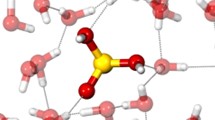 HKU Department of Earth Science
HKU Department of Earth Science
Seminar

Metals and molecular clusters in volcanic and hydrothermal vapors
-
Date
May 10,2022
-
Time
4:00PM - 4:30PM
-
Venue
Zoom only
-
Speaker
Mr. HUI Chi Hang Department of Earth Sciences, The University of Hong Kong
Hydrothermal and volcanic systems host a wide range of aqueous (liquid and vapor) metals and acids with unusual stabilities and molecular structures. The presence of such molecular species in hydrothermal media has important implications for metal speciation, transport, and deposition. For instance, the dissolution and dissociation of molecular acids, e.g. HCl and HF, is critical in controlling the acidity and therefore the speciation of aqueous metal and organics. The purpose of this study is to investigate the speciation and stability of an important but often overseen oxoacid, namely sulphurous acid H2SO3, under ambient (25°C) and hydrothermal conditions (> 200°C), with a particular focus on the acidity (pKa) in the aqueous phase, as a function water density and temperature. Preliminary results from our Car-Parrinello molecular dynamic (CPMD) simulations suggest that H2SO3 dissociates rapidly and fully towards the bisulphite anion HSO3- and H3O+ at 25°C, but would break down forming the SO2 and H2O at temperatures beyond 200°C. This presentation will further discuss temperature-dependent acidity constants pKa derived from our CPMD simulations. As part of this theme, I will also present results from ongoing CPMD simulations of copper nanoparticles (Cu)n (n ≤ 10) in hydrothermal aqueous media, as well as in a mixed binary H2O-H2S. These calculations have been initiated to explore the stabilities of these copper clusters in solution (at ambient and elevated PT), and to look for unusual structures among metal/metalloid nanoparticles that would exist as precursor species during ore formation.
Additional information: Mr. HUI Chi Hang Wallace, wallh817@connect.hku.hk
